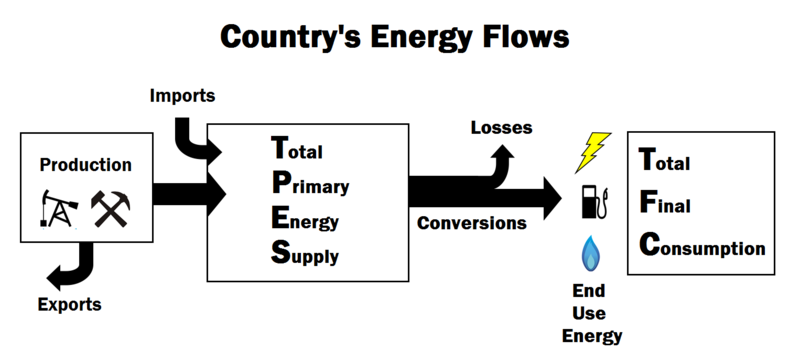Total primary energy supply: Difference between revisions
m (1 revision imported) |
m (1 revision imported) |
||
| (One intermediate revision by one other user not shown) | |||
| Line 2: | Line 2: | ||
[[category:371 topics]] | [[category:371 topics]] | ||
[[Category:Done 2017-07-01]] | [[Category:Done 2017-07-01]] | ||
<onlyinclude>'''Total primary energy supply''' (TPES) is the total amount of [[primary energy]] that a country has at their disposal. This includes [[imported energy]], [[exported energy]] (subtracted off) and [[energy production|energy extracted from natural resource]]s ([[energy production]]). </onlyinclude>Usually TPES is thought of as being the sum of all primary energy sources, but some [[end use energy]] must be taken into consideration. This comes from the fact that TPES includes both imports and exports. The net amount of [[electricity]] traded (imports - exports) and the net [[secondary fuel]]s (for example amount of [[gasoline]] imported - amount of gasoline exported) become part of the TPES. | [[Category: Translated to French]] | ||
[[fr:Approvisionnement total en énergie primaire]] | |||
<onlyinclude>'''Total primary energy supply''' (TPES) is the total amount of [[primary energy]] that a country has at their disposal. This includes [[imported energy]], [[exported energy]] (subtracted off) and [[energy production|energy extracted from natural resource]]s ([[energy production]]). </onlyinclude>Usually TPES is thought of as being the sum of all primary energy sources, but some [[end use energy]] must be taken into consideration. This comes from the fact that TPES includes both imports and exports. The net amount of [[electricity]] traded (imports - exports) and the net [[secondary fuel]]s (for example, amount of [[gasoline]] imported - amount of gasoline exported) become part of the TPES. | |||
In contrast to the total primary energy supply, countries have a [[total final consumption]] of [[energy]], which focuses on the [[end use energy]]. | In contrast to the total primary energy supply, countries have a [[total final consumption]] of [[energy]], which focuses on the [[end use energy]]. | ||
Latest revision as of 00:02, 27 September 2021
Total primary energy supply (TPES) is the total amount of primary energy that a country has at their disposal. This includes imported energy, exported energy (subtracted off) and energy extracted from natural resources (energy production). Usually TPES is thought of as being the sum of all primary energy sources, but some end use energy must be taken into consideration. This comes from the fact that TPES includes both imports and exports. The net amount of electricity traded (imports - exports) and the net secondary fuels (for example, amount of gasoline imported - amount of gasoline exported) become part of the TPES.
In contrast to the total primary energy supply, countries have a total final consumption of energy, which focuses on the end use energy.

In the data visualization below, click on different countries to see what the energy mix looks like. Be aware that some countries (like Canada, or OPEC countries like Kuwait) export energy (like electricity or gasoline), which shows up as a negative amount on the line chart. Often these exports would normally be part of total final consumption (see figure 1), but because they're exported, they're part of the total primary energy supply.
References
- ↑ Created internally by a member of the Energy Education team.

